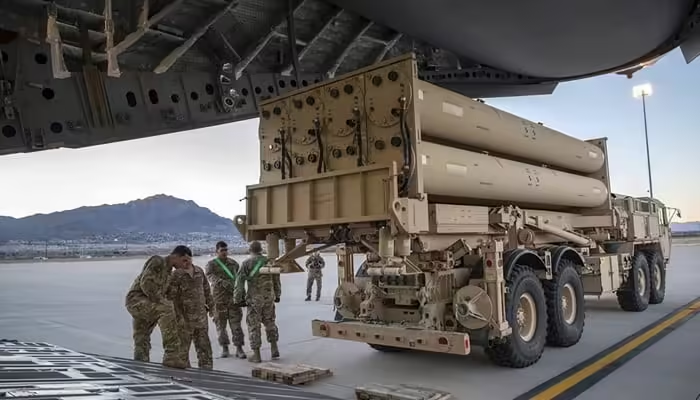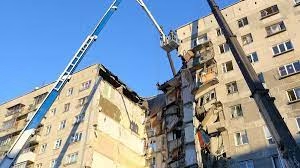In a significant move amid rising tensions in the Middle East, the United States has deployed its latest and highly advanced Terminal High Altitude Area Defense (THAAD) missile system in Israel. The deployment of this sophisticated anti-missile system, along with its operational crew, comes in response to recent ballistic missile threats in the region, specifically following an Iranian attack earlier this month. The move underscores the deep military cooperation between the U.S. and Israel, particularly in the realm of missile defense, as the two nations seek to bolster Israel’s ability to intercept and neutralize missile threats.
THAAD: America’s Cutting-Edge Defense Technology
THAAD is one of the most advanced missile defense systems in the world, designed to intercept and destroy short, medium, and intermediate-range ballistic missiles during their terminal phase. Developed by Lockheed Martin, the system is equipped with powerful radars and missile interceptors that can track and engage incoming threats at high altitudes, making it an essential component in Israel’s multi-layered defense network.
U.S. Defense Secretary Lloyd Austin, speaking about the deployment, expressed confidence in the system’s readiness. “We have the capability to make the THAAD anti-missile system operational soon,” Austin stated, reaffirming that the U.S. is moving forward according to plan to ensure that Israel’s defense systems are fortified in the face of growing regional threats.
Heightened Threats and U.S. Response
The decision to send THAAD to Israel was prompted by a recent Iranian ballistic missile strike targeting Israel. The attack raised alarm bells across the region and prompted the U.S. to reinforce Israel’s defense capabilities. This deployment is not just symbolic but is a clear demonstration of America’s unwavering support for Israel’s security. Given the strategic importance of the Middle East, ensuring Israel’s defense against missile threats is a critical priority for U.S. foreign policy.
The Iranian missile attack highlighted the increasing volatility in the region, as various groups and states with adversarial relations toward Israel continue to advance their missile and rocket capabilities. By deploying THAAD, the U.S. is taking proactive steps to ensure that Israel can defend itself against any such future threats, thereby maintaining stability in a region that is prone to sudden escalations of violence.
Al-Qassam Brigades Release Video of Israeli Tank Destruction
In a parallel development, the Palestinian militant organization Hamas, specifically its military wing, the Al-Qassam Brigades, has released a video showing the destruction of an Israeli tank. The incident reportedly took place in the Jabalia camp located in northern Gaza. According to the Al-Qassam Brigades, the tank was destroyed by a mine, as seen in the footage that has been widely circulated online.
This incident comes at a time of heightened conflict between Israel and Palestinian militant groups, particularly in Gaza. The Al-Qassam Brigades, known for their resistance operations, have continued to carry out attacks against Israeli military targets despite the sophisticated defense systems Israel has in place.
The video release is being seen as part of a broader strategy by Hamas to demonstrate their ability to inflict damage on Israeli forces, even as Israel continues to maintain its military superiority. The Jabalia camp, a site of intense clashes in recent weeks, has been one of the focal points of the ongoing conflict, where Israeli forces and Palestinian militants have been engaged in a violent confrontation.
U.S. and Israel’s Strengthened Defense Collaboration
The THAAD deployment also sends a strong message to other regional actors that the U.S. is committed to maintaining Israel’s qualitative military edge. The advanced system complements Israel’s existing Iron Dome and David’s Sling defense systems, which primarily handle shorter-range threats such as rockets and mortars. With the addition of THAAD, Israel now has an enhanced capability to address more sophisticated missile threats from adversaries like Iran and Hezbollah.
In the wake of the Iranian ballistic missile strike, U.S. officials made it clear that the protection of Israel’s airspace was a priority. This sentiment was echoed by Austin, who emphasized that this move is part of a broader strategic alignment between the U.S. and Israel to counter growing missile threats in the region. Israel’s Prime Minister has also expressed gratitude for the U.S. support, highlighting the importance of the defense relationship between the two countries.
Escalation in Gaza and its Regional Impact
Meanwhile, the conflict between Israel and Palestinian militants shows no signs of de-escalation. The destruction of the Israeli tank in Jabalia is the latest in a series of attacks that highlight the ongoing tension in Gaza. The Israeli military’s response has been swift, with airstrikes targeting Hamas positions and infrastructure in Gaza.
The cycle of violence in the region has broader implications for the Middle East, where proxy conflicts and external actors often exacerbate local tensions. The ongoing conflict in Gaza not only threatens the fragile ceasefires that are periodically brokered but also has the potential to draw in other regional players, further complicating the situation.
A Region on Edge
The deployment of the THAAD missile defense system in Israel is a critical step in ensuring the country’s ability to defend itself against escalating missile threats, particularly in light of recent Iranian aggression. At the same time, the continued violence between Israeli forces and Palestinian militants, such as the recent tank destruction in Gaza, underscores the volatile nature of the region.
As the U.S. and Israel strengthen their military cooperation, the situation in Gaza and the broader Middle East remains precarious. The hope is that advanced defense systems like THAAD will not only protect Israeli citizens but also serve as a deterrent to further escalation, ultimately contributing to stability in the region. However, with ongoing conflicts and deep-rooted tensions, achieving long-term peace will require much more than just military solutions.



